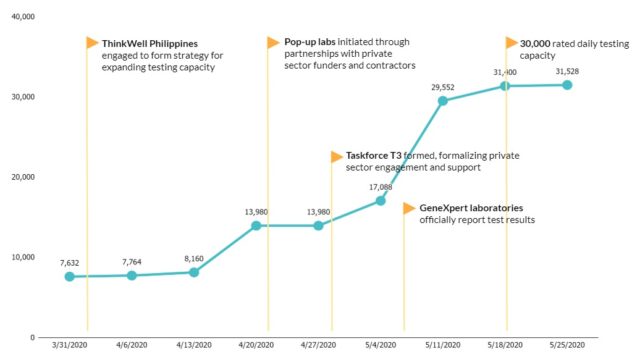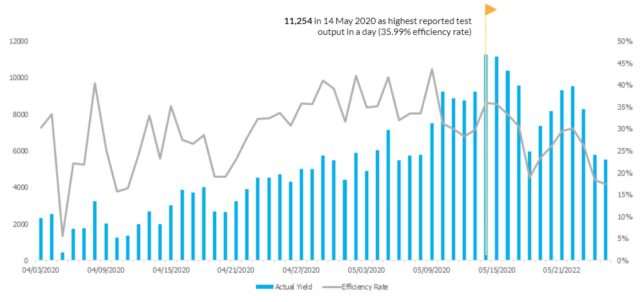Four months since the first confirmed case of COVID-19 in the Philippines, the number of cases has risen into the thousands. Testing capacity has expanded rapidly, but testing continues to limit the Philippines response.
The Philippines has adopted a “whole of government, whole of society” approach to address this global pandemic, grouped around four main components – Detect, Isolate, Treat, and Reintegrate. Detection is the critical first step in managing and controlling the spread of COVID-19 and can determine consequent strategies. However, at the onset of the pandemic, the country had very limited testing capacity. The Department of Health (DOH) formulated and adopted four key strategies to address this: (1) maximize capacity of existing laboratories, (2) certify more laboratories, (3) establish “big testing centres” or pop-up laboratories in strategic areas, and (4) explore other testing approaches. On April 24, the National Task Force on COVID-19 set a target of 30,000 tests per day by May 30.
Increasing the Philippines’ testing capacity
In March, the Research Institute for Tropical Medicine (RITM) was the only laboratory in the Philippines with the capacity to conduct the World Health Organization-recommended RT-qPCR testing for COVID-19. Since then, RITM has tirelessly supported public and private testing facilities to develop COVID-19 testing capacity. As of May 25, 34 RT-qPCR facilities have been certified across the Philippines, with 40 more in process. Eight laboratories with automated GeneXpert® COVID-19 systems have also been certified, and at least 20 more are awaiting certification. As of time of writing, these efforts have led to a rated daily testing capacity of 31,528 (Figure 1) – surpassing the government’s target.

Towards the end of April, the Task Force T3 (Test, Trace, and Treat) initiative was officially formed. This public-private coalition is currently prioritizing testing. T3 has mobilized the private sector to construct 15 standards-compliant pop-up turnkey laboratories in priority areas, and these new pop-up labs will contribute at least 9,000 more tests per day. The group also provides support in supplies mobilization, IT-based inventory system development, as well as donation of automated testing platforms.
30,000 tests per day – a practical possibility?
When the rubber hits the road, a whole new set of challenges emerge. The highest actual yield of tests officially reported to date is 11,254 (on May 14), only 35.99% of the rated testing capacity (Figure 2). Testing facility production averages only 29.30% of rated capacity. Performance is undermined by tedious procurement processes and lack of inventory management system, resulting in the slow replenishment of supplies. Some facilities also need more trained personnel, and deployment of volunteers can be hampered by lockdown restrictions. Specimen collection is uneven across the country, with some local government units aggressively setting up swabbing sites, leading to the overloading of some testing facilities whilst others are underused.

Lessons learned
Public outcry for immediate mass testing pushes the government to rapidly scale up, but strategy execution must stay true to the science of testing. This has been achieved by upholding facility standards that ensure integrity and accuracy of testing, and carefully evaluating new innovations brought to the table. The government, with technical support from ThinkWell Philippines, regularly convenes an expert panel composed of public health practitioners, scientists, and laboratory experts to ensure that strategies undertaken to increase testing capacity are efficient without compromising quality. As part of the government’s efforts to build public confidence on the status and results of these strategies, information is released to the public daily through virtual press conferences, situationers, and an online COVID-19 dashboard and data warehouse.
Whilst rapidly scaling up capacity is necessary; it is not sufficient. Equal attention needs to be given to maximizing productivity. This is being supported by developing an IT-based inventory monitoring platform, continuously engaging the private sector to enhance supply mobilization, and developing zoning strategies to systematically match local areas and swabbing sites to current and potential testing facilities.
The challenges of this pandemic demand the engagement of diverse stakeholders. Collaborative work between the public and private sectors and constant communication with local government units produce palpable results in expediting testing capacity. A centralized approach to coordination and planning continues to prove useful in rallying stakeholders and streamlining all efforts into one coherent strategy.
About the Authors
Christian Edward Nuevo 1 , Jemar Anne Sigua 1, Matt Boxshall 2, Pura Angela Wee Co 1, & Maria Eufemia Yap 1
- Strategic Purchasing for Primary Health Care (SP4PHC), ThinkWell Philippines
- ThinkWell United States of America
Dclaration: Authors declare no competing interests.